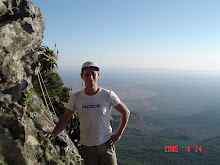
Of late, my perspective of the “Ledge” on
Glancing up one gets the impression that the arête will yield a few meters of tricky climbing and then the angle eases. In fact this is not the case. The first pitch is tricky and quite bold. It took several starts to work it out including placing pro around a dicky bollard on the right of the arête. On the arête at about 4m one can spy a good hold. A thin lie back move gets one to the hold where a less than optimal RP or other micro-nut and half-in cam was be placed on the first ascent. On a repeat ascent a pretty good Rock 7 (or an 8 will also work) was found to fit in a cunning constriction rendering the pitch much safer.
From here there follows a tricky step up to a rail. One then has some respite on the left of the arête but as it gets chossy you avoid the lichen by swinging back right around the arête to get to a rail and ledge. Again there is an easy option up left but sticking to the arête yields excellent airy climbing and the pro is good.
The second pitch starts on the face 3m right on good crimps to a rail that is thin to the right but much better to the left of the arête. Another little trick gets one to easier moves and another decent ledge. One can continue straight up on the left but this really amounts to climbing Quiver Crag and does no justice to this route.
The third pitch again starts around to the right of Quiver Crag with a powerful crank to a good rail. One is still in the shade if it still morning. A high nut/RP is placed and then a lie back move is made on the edge on the right which is rather reachy and balancy for us vertically challenged dudes. But a good rail with excellent pro is arrived at. One then steps around to the right and does awkward and balancy moves to get back left and into the obvious crack or a straight through lie back crank allows you to attain the crack. From there it is a doddle but still aesthetic climbing all the way to the abseil station.
It is best to do this section of the route in 3 pitches both for the leader and the follower as there are large ledges at the start of each pitch. With rope stretch a second can deck if one combines pitches. The route is not trivial to do on-sight.
Anyway I did not rest there and considered adding pitches on the lower two buttresses and this was successfully achieved. With Robert Breyer another aesthetic pitch was added on an arête situated just off the trail where Africa Ledge ends on the corner of Fountain. It is a nice easy warm-up on good clean rock.
I then again returned on the 29 January to inspect the final buttress and again it yielded to my efforts and an interesting pitch evolved at around grade 20. As none of my mates wanted to play with me I did the first ascent solo using a TRE as a self belay device and tying it off every now and then. It was objectively fairly safe but subjectively quite scary.
The route was opened on-sight without pre-inspection or any cleaning except the second pitch that had a lot of lichen and loose flakes in places. The upper pitches had enough lichen and scary, brittle little holds to be very exciting at times. This has now been improved to render another stoncking good addition to the Ledge repertoire and a definite test piece for anyone who is maxing at grade 21 or even 22. Repeat ascents, as is so often the case, can belittle one’s appreciation of the “head” factor required to on-sight a route such as this. I certainly found it more mentally and physically challenging than the Good Doctor 22a route we have both done a few times. So time will tell.
Start: Just before the India Venster trail turns the corner from
Pitch 1 12m 16
Climb the arête to the top of the buttress.
Pitch 2 15m 20
Ahead is the next buttress. Start on the right on blocks under the huge overhang. Climb up into the corner and rail right onto the arête and round it to easier ground. Continue easily to the top.
Pitch 3 20m 21:
Step up on blocks to the rail on the right side of the arête and then to thin moves up to a good hold on the edge at about 4m. Place some pro including a half-in cam and an RP and a reasonably good rock 7 and then do a lie back into and under cling to reach the next rail. Continue up the arête with good gear on the left. Avoid the lichen and choss by staying on the arête higher up – the holds unfold as you climb. Belay on the large ledge.
Pitch 4 15m 20
Step up onto the face on the right around the corner to a thin rail. Continue up the arête to another large ledge.
Pitch 5 20m 22
Climb up to the obvious rail just right around from the main edge of the arête (see photo). Lay back up the right edge after placing a high micro-nut or RP and the step around to the right. Continue up a move and then back left into the crack and continue more easily to the bolted abseil point.
First ascent: Pitches 3 to 5 Charles Edelstein and Tony Dick January 21 2009.
Pitch 1 Robert Breyer and Charles Edelstein
Pitch 2 Charles Edelstein



No comments:
Post a Comment